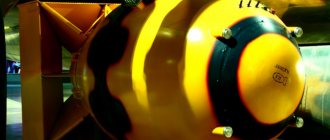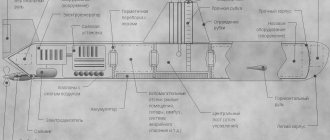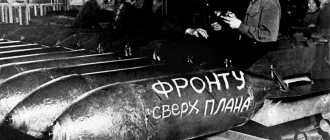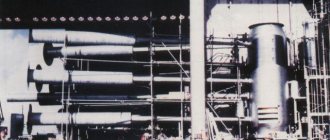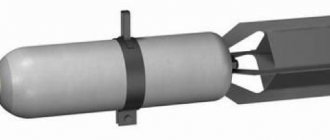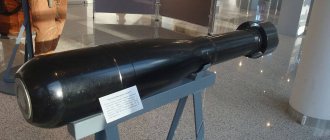Today you can increasingly hear about such a thing as cluster munitions. They write about him in the Ukrainian, Russian and Western press. This term is often mentioned among the population, which by chance became involved in military confrontations. But what is a cluster bomb? What does it consist of? Where is it used? And for what reason does it belong to the category of prohibited ammunition in the world?
How many mines or bombs are in one ammunition?
One cluster bomb contains at least ten mines and small parts for them, located, as if on store shelves, on separate partition walls. Simply put, this is a kind of nesting doll, that is, bombs in a bomb that spill out after the detonation of the shell in the air and scatter in the zone of their fall.
Bombs contained in an aircraft can be filled with destructive elements and small fragments. According to preliminary data, they have a wide spectrum of action and are used to destroy enemy personnel, as well as to eliminate armored vehicles.
From the history
When designing, we adhered to the idea of large-scale destruction of enemy personnel. The first sample was fragmentation cores with explosives. Then they started putting hunting shot inside, it was more effective. Later they were loaded with grapeshot like cannons. This type was distinguished by its range, but reloading was difficult, so the method of using grapeshot types was limited. They were sent against cavalry and infantry.
The problem of scarcity was solved in the 19th century. Then Henry Shrapnel, a British army captain, came up with a hollow structure for filling. After this innovation, the ball mine was able to explode at a given distance, and the damage caused increased noticeably.
Specifically, cluster bombs were the result of the creation of new technologies for bombing. At the very beginning, they were thrown out manually, the pilot simply took the projectile and threw it right out of the cockpit. Efficiency was high, aiming was not very good.
The prototypes of the newest models came out in the 30s of the last century. Low accuracy was compensated by new technologies. The project belongs to the Germans, they created the SD-2 butterfly bomb and successfully used it in a clash with the Poles. There are three stages:
- partial tearing in flight to cover an area;
- detonation upon impact from landing;
- delayed effect, remaining on the ground, they work like regular mines.
Soviet specialists also developed similar butterflies. Their mass distribution began during the Soviet-Finnish conflict. By the time of World War II, they were already more modernized and were already hitting tanks and other armored vehicles. The war ended, but work was carried out even more actively. They were led by America, and the United States used them in the Vietnam and Korean conflicts.
In 1980, the UN banned cluster bombs as inhumane. The story should have ended there, but it happened differently. The world's leading military powers, including Russia, China and America, refused to accept this convention. This does not mean that they continue to fight with inhumane means. In each state, work is underway to improve accuracy. They continue to this day, with an emphasis on homing devices. They will be able not only to accurately hit selected areas, but also to reduce losses among the population.
If you are interested in the issue of weapons technology, then pay attention to the article “What is the principle of operation and damage from a bullet with a displaced center of gravity.”
What is the principle of operation of cluster munitions?
Before a cluster bomb is used for its intended purpose, it is loaded into a special compartment on board the fighter. The plane then takes off, and after receiving the order, the pilot drops the projectile down. In turn, the ammunition, released into “free floating” at the given coordinates, releases a parachute at a certain point. Then braking occurs, and the projectile is leveled in the horizontal plane.
After this, the ammunition begins to get rid of its filling one by one. Moreover, all dropped mines and bombs are also equipped with unique braking devices, which allows them to be moved to a vertical position. And thanks to the order established by the developers of the explosive device for dropping mines, the area marked by the military is completely covered. According to preliminary information, one aerial bomb shell is capable of penetrating 17 cm thick armor.
Climate weapons
Unlike the above-described types of extermination of humanity, this weapon is hypothetical. It is assumed that there will be an artificial impact on the weather and climate of both a single territory and an entire continent.
However, there have been several examples of such changes in history. The most famous is Operation Spinach, when the American military during the Vietnam War achieved a significant extension of the rainy season and increased its intensity three times. Forest roads turned into swamps, enemy communications were disrupted. Also, the natural balance was seriously disrupted for many years, entire populations of animals and plants perished. Despite the monstrous financial costs of the operation, the real combat benefit was small.
Can mines not explode after being dropped?
In addition to the fact that a cluster bomb has powerful explosive force, it also poses a certain hidden threat. In this case, we are talking about the fact that for certain reasons (in particular, due to an imperfect fuse mechanism), mines fired from the bomb casing do not explode. This especially applies to the very first batches of submunitions.
Currently, less than 5% of new air bombs fail to fire and fall to the ground, effectively turning into anti-personnel mines. Moreover, after being immersed in the ground, these shells could retain their detonation properties for a long time and explode after contact with third-party objects.
To eliminate this problem, for example, the US military painted the mines inside the bombs in different bright colors. It was assumed that if the cluster bomb suddenly did not work, its unexploded elements would be easily found by sappers by color. However, this option was not ideal, since children were at risk. Let us remind you that often a child’s attention is attracted by bright and beautiful objects.
Later, the use of cluster bombs was carefully tested and refined. Thus, the CBU-105 aerial bomb appeared, weighing 420 kg and containing up to 40 Blu 108/B mines. Moreover, each projectile inside the bomb contained a flight correction system, and was also programmed to self-destruct in case of failure.
Bullets dum-dum
These bullets, also known as hollow-point bullets, got their name from the fact that they were developed at a British arms factory located in the working-class suburb of Calcutta, Dum Dum.
Such bullets, with the casing cut off at the nose, open like a flower and cause terrible wounds. In the early 1890s, dum-dum bullets appeared, and already in 1899 they were banned by the Declaration on the Non-use of Easily Expanding and Flattening Bullets, adopted at the Hague Conference - the first peace conference in history, convened on the initiative of the Russian Emperor Nicholas II.
Where did they come from and who invented cluster bombs?
The Germans can easily be called the pioneers in the production of cluster bombs. Thus, unique cluster munitions were used by Luftwaffe pilots in 1939 against Polish cavalry and infantry. For example, the AB 250-3 projectile not only looked like a modern aerial bomb, but was also filled with 108 small SD-2 fragmentation-type mines. Such mines looked like a steel cylinder the size of a faceted glass and weighed up to 2 kg.
After the ammunition was released from the plane, a funny propeller appeared above it, stopping it in motion. Then the shell opened, and the filling of the cluster bomb and explosive device spilled out and was used for its intended purpose.
Based on historical information, the first prototypes of modern bombs were produced with one of three types of fuses. In particular, the AZ 41 fuse was used, which helps to activate the projectile either directly in the air or after it hits the ground. A fuse such as AZ 67 was also used, which helps to explode the projectile approximately 4-30 minutes after it falls.
And finally, the third type of ammunition was SD-2, which turns aerial bombs into anti-personnel fragmentation mines. Moreover, such cluster munitions included three types of fuses at once, but only in different proportions. Consequently, the first part of the shell’s contents hit enemy personnel from the air, the second part covered the soldiers on the ground, and the third had the effect of a delayed explosion and did not allow the orderlies to assist the wounded.
Modernity
But not everything in the field of cluster munitions has been reduced to modern variations of German anti-personnel “butterflies”. The design thought also took care of the fight against a large number of Soviet tanks, this nightmare that haunted the Western military for many decades. Engineers tried to combine the properties of precision-guided and cluster munitions in one system and thereby use the best properties of both systems.
High-precision homing anti-tank ammunition is expensive, primarily due to the means of delivering it to targets. And if you create one cluster munition, which contains several high-precision homing submunitions, then this becomes a solution to the problem. Thus was born the American anti-tank cluster system CBU-97/CBU-105 Sensor Fuzed Weapon, containing ten submunitions, each containing four homing warheads. Thus, one SUU-66/B cassette is theoretically capable of hitting up to 40 tanks. In reality, not all warheads will detect targets, or several warheads can capture the same target. However, the probability of hitting five to ten tanks with this system is quite high.
Where were cluster shells used?
Cluster shells were used by the US military during the Korean War. To do this, they used SD-2 ammunition already known from the Germans, which was slightly modified and renamed AN M83. Later, American developers came up with new bombs called Blu 26/B. At that time, these were round ammunition made of lightweight alloy. Moreover, their filling included up to three hundred 5.5-mm balls made of natural steel. And this innovation had a certain effect on the explosion of a cluster bomb.
In addition, cluster bombs were used in Syria, Libya, Yugoslavia and other countries where there was military conflict. Not long ago, people started talking about these dangerous and prohibited projectiles in Ukraine.
Similar aerial bombings were also discussed in the media during recent events in Yemen.
Anti-cassette policy
The high efficiency of cluster munitions, especially anti-personnel munitions, proven in many local wars of the late 20th and early 21st centuries, prompted designers to further improve this type of weapon, especially in conditions where the military’s disappointment in nuclear weapons was clearly evident. The generals came to the conclusion that, given the enormous cost and complexity of use, nuclear weapons on the battlefield are ineffective. Figuratively speaking, the use of nuclear warheads in field combat is reminiscent of hitting mosquitoes with a concrete slab. Nuclear weapons are more of a means of intimidation, a method of military-political pressure, than actually a weapon.
Covert application
Russia, like other countries that use such bombs, tries not to advertise their use. International human rights groups often criticize Russia for using cluster bombs in Syria, killing civilians.
Footage of RBK-500 class cluster bombs appeared in several reports by Russian television channels from the Khmeimim airbase in Syria.
- RT returned footage of cluster bombs to its story
- Russian cluster bombs in Syria: questions, problems and mysteries
Thus, in the RT channel’s report on the visit of the Russian Minister of Defense to the Khmeimim base, aired on June 18, 2016, a Russian military pilot was shown inspecting a Su-34 fighter-bomber with suspended RBK-500 bombs. The bombs were shown in a medium shot with clearly visible markings.
Media playback is unsupported on your device
How did British cluster bombs end up in Yemen?
When bloggers drew attention to this shot, the TV channel cut it out of the story, but it was noticed in the press, and RT returned this fragment back. As RT explained to the BBC, the fragment was cut out by a social media editor not to hide the use of cluster bombs by the Russian army, but for security reasons: the video showed a close-up of the pilot
As RT explained to the BBC, the fragment was cut out by a social media editor not to hide the use of cluster bombs by the Russian army, but for security reasons: the video showed a close-up of the pilot.
It is not only Russia that is being criticized. In October 2014, the human rights organization Human Rights Watch accused Ukrainian troops of using cluster bombs during shelling of Donetsk.
Napalm
Napalm is condensed gasoline. It is highly flammable and emits huge amounts of black smoke when burned. This substance easily sticks to everything, which makes this substance even more dangerous. Napalm was first used during World War II. However, the most widespread use of napalm occurred during the Vietnam War. When a person is hit by napalm, he or she experiences burns and poisoning with toxic gases. Often a person dies from burns and suffocation. Despite the fact that napalm is prohibited by the UN convention, it is widely used in almost all modern major military conflicts.
